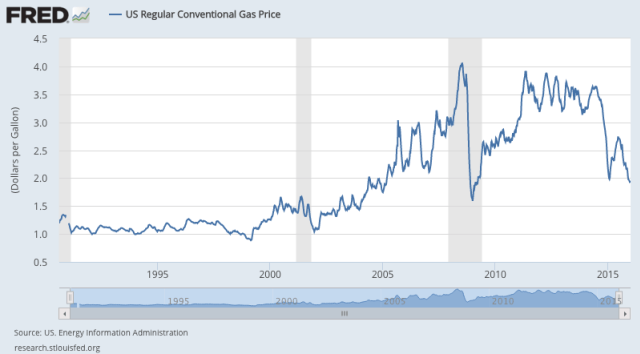Gas prices are down, driving is up, and so, too, is carbon pollution. In a little over a year, the US has given up about one-sixth of the progress it made in reducing transportation’s carbon footprint.
For more than a decade, America was making real progress in reducing is car dependence. The growth of driving slowed at the turn of the millennium, and declined from 2004 onward. The average American went from driving about 27.6 miles per day to driving just 25.7 miles per day—a nearly seven percent decline.
Demographic and technological factors played a role, but the big runup in gas prices—especially from 2004 to 2008, when gas broke through the $3/gallon and $4/gallon barriers—appeared to dramatically decrease the demand for driving.
But for more than a year now, gas prices have been ebbing downward. All told, they’ve fallen by nearly half, from $3.62 gallon in early 2014 to $1.92 gallon in most of the nation today.
From our partners:
And as driving has gotten cheaper, Americans have begun driving more—a simple illustration of what economists call the “price elasticity of demand.” Monthly data on driving from the US Department of Transportation shows driving is up about nine tenths of a mile per person per day over the past year.
Collectively, we’re driving more than 3.1 trillion miles per year, after holding the line just below three trillion for several years.* That added 100 billion miles of driving per year means more carbon pollution. At a fleet average of about 20 miles per gallon, this added driving implies about 5 billion gallons of additional gasoline and about 44 million tons of carbon emissions nationally. So far, this increased driving has erased about one-sixth of the progress the country made in reducing transportation related carbon emissions since 2008.
And we can’t expect that all these changes will disappear if, and when, gas prices increase again. Because cheap gas has also prompted Americans to buy less fuel efficient vehicles, today’s prices will lock in lower levels of efficiency for more than a decade.
On top of that, the congressionally approved bailout of the bankrupt highway trust fund (largely paid for with a combination of raiding federal reserve bank balances and selling off the strategic petroleum reserve (at exactly the wrong time) have the effect of insulating highway users from the true costs of building and maintaining the roads they drive on.
Taken together, cheap gas, more driving, and dirtier, less efficient vehicles make a mockery of the high-minded rhetoric coming out of last month’s Paris accords on global warming. While we’ve nominally agreed to take long term steps to reduce our carbon emissions, when it comes to the economic signals that matter—the price we charge for gas and the billions of dollars of subsidies for car travel—we’re clearly bending the curve in the wrong direction. And that makes the ultimate objectives of avoiding climate change harder to achieve and far less likely.
* These calculations are based on the numbers reported in the U.S. Department of Transportation’s Traffic Volume Trends through October 2015. As Tony Dutzik of the Frontier Group reports, initial estimates from 2014 have been revised down, so we may expect a similar downward revision of the 2015 data. Still, the upward trend is evident even with the corrections.
This article originally appeared in City Observatory.



















